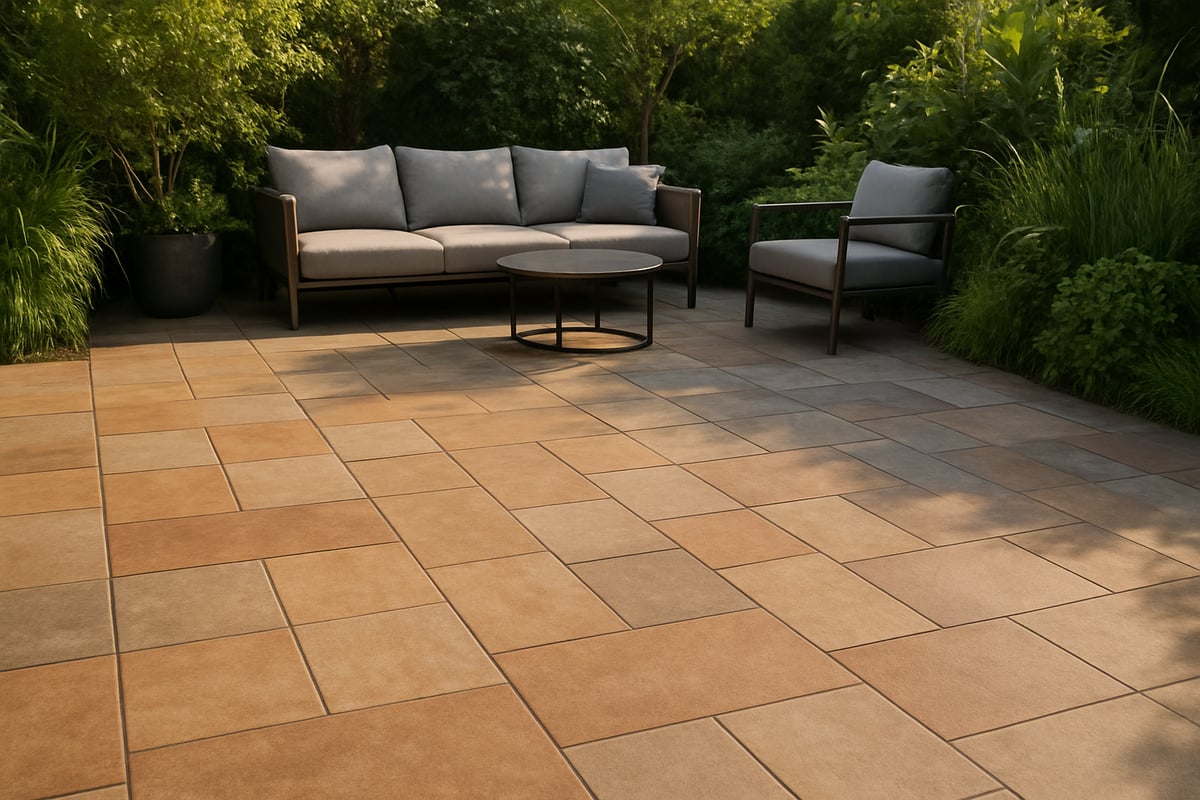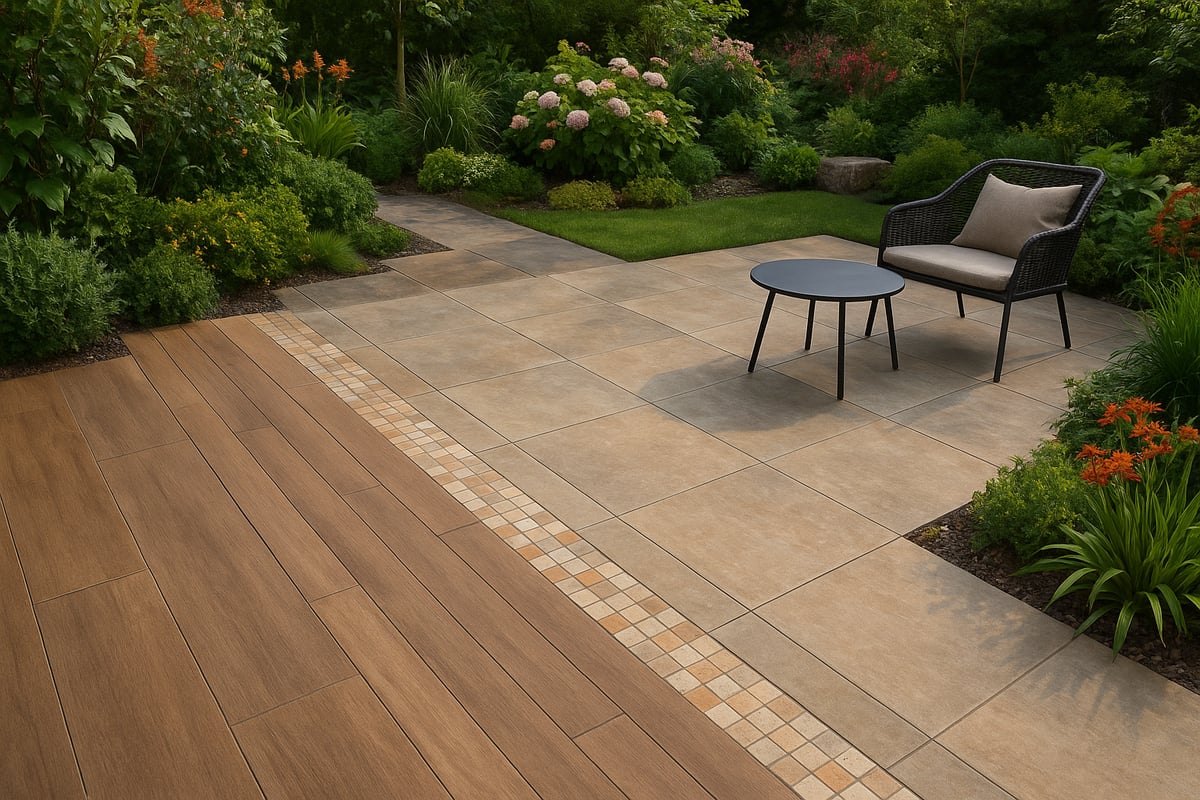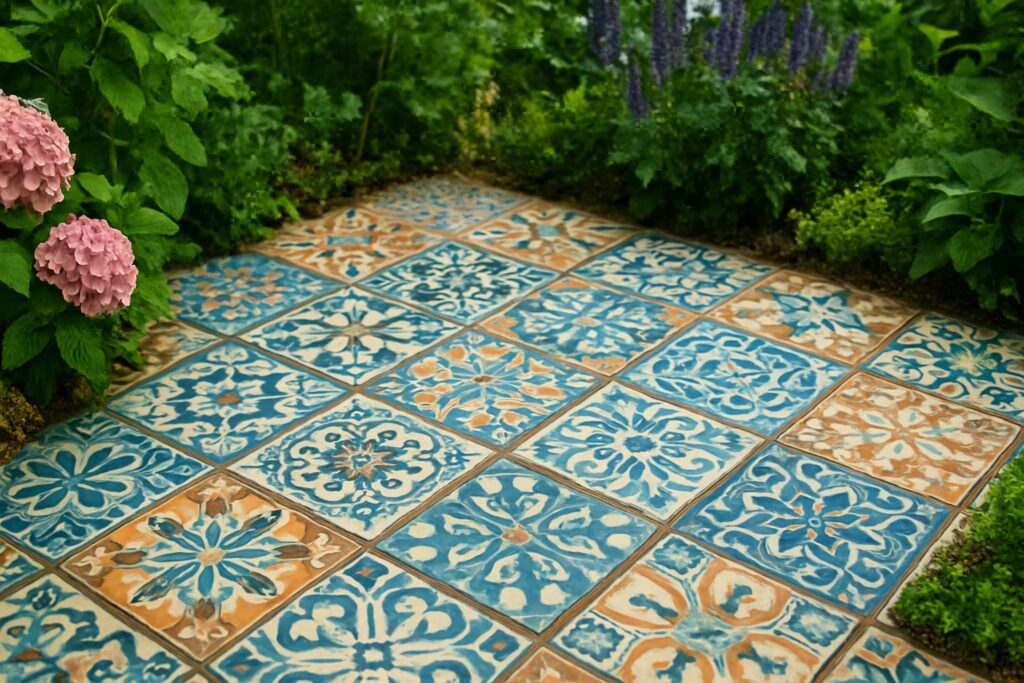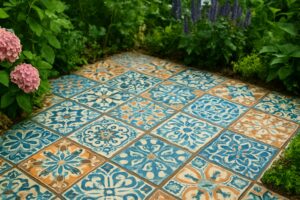Imagine stepping into your backyard and encountering a breathtaking mosaic of garden ceramic tiles underfoot. The vibrant patterns, smooth textures, and natural hues instantly elevate your outdoor retreat, making everyday moments feel extraordinary.
Why settle for ordinary when you can transform your space with materials that blend style, durability, and easy care? In 2025, garden ceramic tiles offer homeowners, designers, and DIY enthusiasts endless options to personalize and enhance any outdoor area.
This comprehensive guide empowers you to make informed choices, from selecting the perfect tiles to mastering installation and long-term care. Ready to discover the latest trends and practical tips for creating your dream garden escape?
Explore expert insights, inspiring design ideas, and sustainable solutions to turn your outdoor vision into reality.
The Benefits of Garden Ceramic Tiles for Outdoor Spaces
Imagine stepping outside to a garden where every surface is a canvas of color, texture, and style. Garden ceramic tiles bring this vision to life, offering a blend of beauty, function, and long-term value for any outdoor space.

Versatility in Design and Application
Garden ceramic tiles come in a vast range of colors, patterns, and finishes. Whether your garden is modern, rustic, or Mediterranean inspired, you will find options that match your vision.
Tiles can be installed on patios, walkways, pool surrounds, or even as accents in outdoor kitchens. With digital printing, these tiles can mimic natural stone or hardwood, giving you design freedom without the upkeep.
This versatility means garden ceramic tiles adapt to any space, seamlessly connecting indoor and outdoor areas while enhancing the overall aesthetic.
Durability and Weather Resistance
One of the standout features of garden ceramic tiles is their ability to withstand harsh weather. These tiles resist moisture, frost, and UV rays, making them perfect for North American climates.
Unlike wood or concrete, garden ceramic tiles handle freeze thaw cycles without cracking or fading. Their surface remains intact through temperature changes, delivering reliable performance year after year.
When compared to traditional materials, garden ceramic tiles offer greater longevity, reducing the need for costly repairs or replacements.
Low Maintenance and Easy Cleaning
Caring for garden ceramic tiles is refreshingly simple. Their non porous surface blocks stains and prevents mold or algae from taking hold.
A routine sweep and a rinse with mild detergent are all that is needed to keep tiles looking pristine. This ease of maintenance is a major advantage over paving stones or wood, which often demand sealing or deep cleaning.
Homeowners save both time and money, making garden ceramic tiles a practical choice for busy lifestyles.
Safety and Slip Resistance
Safety is a top priority in any outdoor space. Garden ceramic tiles are available in textured and matte finishes, which help prevent slips in wet conditions.
Industry ratings like R11 and R12 ensure tiles meet high standards for slip resistance. This makes them an excellent option for families with children or elderly members who need extra protection.
By choosing the right finish, you create a safe, accessible garden retreat for everyone to enjoy.
Eco-Friendly and Sustainable Options
Sustainability is at the forefront of modern landscaping. Many garden ceramic tiles are made with recycled materials and produced using energy efficient methods.
Their long lifespan means fewer replacements, cutting down on waste and resource use. Some manufacturers even offer certifications like GreenGuard or LEED, so you can choose products that align with your environmental values.
Selecting eco conscious garden ceramic tiles supports both your garden’s beauty and the planet’s health.
Increased Property Value and Curb Appeal
Investing in garden ceramic tiles boosts the visual appeal and marketability of your home. A well designed tiled garden can increase perceived property value by up to 20 percent, according to landscaping surveys.
Buyers are drawn to low maintenance, stylish outdoor spaces. For inspiration and guidance on the best options, explore the best tiles for outdoor patio to see how garden ceramic tiles can transform your space and attract potential buyers.
A thoughtfully tiled garden not only elevates your lifestyle but also delivers measurable returns when it is time to sell.
Types of Garden Ceramic Tiles: Styles, Finishes, and Trends for 2025
Choosing the right garden ceramic tiles means understanding the diverse range of styles, finishes, and trends available for outdoor spaces in 2025. Each tile type offers unique advantages, from aesthetic flair to practical durability, allowing you to design a truly personalized garden retreat.

Glazed vs. Unglazed Ceramic Tiles
When selecting garden ceramic tiles, understanding the difference between glazed and unglazed options is essential. Glazed tiles feature a protective, often glossy coating that offers vibrant colors and patterns, making them ideal for decorative features and low-traffic areas.
Unglazed tiles, on the other hand, have a more natural, matte finish and are known for their enhanced slip resistance and durability. These qualities make them perfect for high-traffic garden paths and patios.
| Feature | Glazed Tiles | Unglazed Tiles |
|---|---|---|
| Appearance | Shiny, colorful | Matte, earthy |
| Durability | Moderate | High |
| Slip Resistance | Lower | Higher |
With garden ceramic tiles, you can tailor your choice based on both style and function.
Porcelain Tiles: The Premium Choice
Porcelain tiles are a standout among garden ceramic tiles due to their density and low porosity. This makes them exceptionally frost-proof, stain-resistant, and well-suited for the challenges of outdoor environments.
Available in large format sizes and a vast array of finishes, porcelain options deliver a sleek, modern look while providing superior durability. In 2025, their popularity continues to rise, especially for seamless patios and pool surrounds.
If you desire high-end performance with minimal maintenance, porcelain garden ceramic tiles are an excellent investment for your landscape.
Textured, Patterned, and Mosaic Tiles
Textured, patterned, and mosaic tiles offer endless design possibilities for your garden ceramic tiles project. Patterned tiles can create striking focal points, while mosaics work beautifully for borders, water features, or garden art.
Trending colors and motifs for 2025 include earthy neutrals, geometric shapes, and botanical patterns, adding personality to any space. For more inspiration on the latest styles and textures, explore Outdoor Tile Trends 2025.
Garden ceramic tiles in these styles bring both function and artistry to modern outdoor living.
Wood-Look and Stone-Look Ceramic Tiles
Advances in digital printing now allow garden ceramic tiles to convincingly mimic wood and stone, offering style with practical benefits. Wood-look tiles provide the warmth of natural timber without the risk of splintering or warping, while stone-look options resemble slate or travertine but do not require sealing.
Popular choices include oak, teak, and slate-inspired designs. These garden ceramic tiles deliver durability and easy upkeep, making them a preferred solution for those wanting a natural aesthetic in their garden.
Large-Format and Modular Tiles
Large-format and modular tiles are transforming the way garden ceramic tiles are used in outdoor spaces. Oversized tiles create a seamless, contemporary look with fewer grout lines, while modular systems allow for flexible layouts and easy maintenance.
Common sizes include planks, squares, and trendy hexagons. In 2025, these garden ceramic tiles are favored for their modern appeal and the ability to customize patterns with minimal effort.
Eco-Conscious and Recycled Tile Options
Sustainability is increasingly important in the selection of garden ceramic tiles. Many manufacturers now offer tiles with recycled content or eco-friendly certifications, such as GreenGuard or LEED.
Using these options not only reduces environmental impact but also supports long-lasting garden projects. Case examples highlight successful installations where recycled garden ceramic tiles contribute to both beauty and responsible stewardship.
Custom and Artisanal Ceramic Tiles
For those seeking a unique garden statement, custom and artisanal ceramic tiles are gaining popularity. Hand-painted or bespoke tiles, often crafted by local artisans or small-batch manufacturers, provide one-of-a-kind accents for garden walls, fountains, or pathways.
These tiles allow homeowners to infuse their garden spaces with personality and craftsmanship, making each project truly distinctive.
How to Choose the Right Garden Ceramic Tiles for Your Space
Selecting the perfect garden ceramic tiles for your outdoor area is a balance of function, style, and long-term value. A thoughtful approach ensures your investment brings beauty and durability that lasts for years. Here’s how to navigate the key considerations step by step.

Assessing Your Outdoor Environment
Begin by evaluating the specific conditions of your garden. Sun exposure, rainfall, and temperature changes all play a role in how garden ceramic tiles perform. If your space receives direct sunlight, choose tiles with UV resistance to prevent fading.
Consider moisture levels and drainage. Outdoor areas prone to standing water need tiles with low water absorption rates and a well-prepared base. Heavy foot traffic, such as pathways or dining zones, calls for tiles with higher wear ratings. Proper grading ensures water flows away from your installation, protecting tile longevity.
Matching Style to Garden Aesthetics
Harmonizing garden ceramic tiles with your existing landscape brings cohesion to your design. Look at the colors and shapes in your plants, hardscaping, and architectural features. If your garden leans contemporary, opt for sleek, large-format tiles or geometric patterns.
For a rustic or Mediterranean feel, earth-toned tiles with textured finishes work beautifully. Aim to create visual flow from indoor to outdoor spaces by echoing interior tile styles or color palettes. Mixing tile sizes or patterns can add character, but keep the overall look balanced and intentional.
Evaluating Tile Ratings and Specifications
Understanding tile ratings helps you choose the right garden ceramic tiles for durability and safety. The PEI (Porcelain Enamel Institute) rating measures wear resistance. For outdoor use, select tiles with a PEI rating of 4 or 5.
Slip resistance is also crucial, especially in wet or poolside areas. Look for tiles with a COF (Coefficient of Friction) rating that meets or exceeds industry standards. Frost resistance and low water absorption are vital in climates with freeze-thaw cycles. Always check product specifications before purchasing.
Budgeting and Sourcing Quality Tiles
Set a realistic budget by comparing materials. Standard garden ceramic tiles are often more affordable than porcelain, but porcelain offers superior performance. Prices range widely, so factor in installation costs and long-term maintenance.
When deciding between options, it is helpful to see a direct comparison, such as Comparing porcelain vs. natural stone, to understand the benefits and value. Purchase from reputable retailers or specialty stores, and always inquire about warranties and after-sales support. Quality tiles may have a higher upfront cost but deliver greater savings over time.
Planning Layout and Design
A well-planned layout elevates your garden ceramic tiles project. Use design software or graph paper to visualize patterns and tile placement. Popular patterns include herringbone for movement, basketweave for texture, and straight lay for a classic look.
Consider borders or accent tiles to define spaces or highlight features like fire pits and planters. Modular tile systems allow flexibility if you want to update or expand your design in the future. Carefully plan transitions between different surfaces for a seamless result.
Considering Installation Complexity
Decide whether to tackle the installation yourself or hire a professional. DIY projects can be rewarding but require careful preparation, including substrate leveling and waterproofing. Certain patterns or large tile formats may be challenging for beginners.
Professional installers ensure tiles are properly set and aligned, which is especially important in areas where safety and longevity matter. Be mindful of the project timeline and any disruptions installation may cause in your daily routine. Proper planning reduces stress and ensures a smooth process.
Skyscapes: Premium Outdoor Flooring Solutions
For those seeking expert support, Skyscapes offers luxury solutions for garden ceramic tiles in outdoor settings. Their offerings include porcelain pavers and modular systems designed for Canadian climates, ensuring slip resistance and durability.
Skyscapes provides custom design services and turnkey installation, making the process simple from start to finish. Ontario homeowners praise their attention to detail and code-compliant products. Choosing a specialized provider like Skyscapes ensures your outdoor space is both beautiful and built to last.
Step-by-Step Guide: Installing Garden Ceramic Tiles Outdoors
Transforming your outdoor space with garden ceramic tiles requires careful planning and precise execution. Whether you are a DIY enthusiast or working with a professional, following these steps ensures a durable and beautiful result.

Step 1: Planning and Measuring Your Space
Begin by assessing the area where you plan to install garden ceramic tiles. Measure both length and width, noting any irregular shapes or obstacles like planters and posts. For curved or angled spaces, create a scaled drawing or use digital layout tools to ensure accuracy.
Calculate the total square footage, then add an extra 10 percent to account for cuts and waste. This prevents shortages and ensures consistency if future repairs are needed. Sketch your preferred tile pattern, considering traffic flow and focal points. Careful planning at this stage sets the foundation for a smooth installation of garden ceramic tiles.
Step 2: Preparing the Substrate
A stable, well-prepared substrate is crucial for the longevity of garden ceramic tiles. Choose from these common bases:
- Concrete slab: Level and durable, ideal for most outdoor tile projects.
- Compacted gravel: Provides drainage and a solid base for pedestal systems.
- Pedestal systems: Adjustable supports for rooftop patios or uneven ground.
Ensure the substrate slopes away from structures for effective drainage, generally at a 1 to 2 percent grade. Clean the surface thoroughly, remove debris, and check for cracks or dips. For optimal performance, especially in climates with freeze-thaw cycles, consider using porcelain pavers for gardens that are specifically designed for outdoor durability.
Step 3: Selecting and Arranging Tiles
Select garden ceramic tiles rated for exterior use, with slip-resistant and frost-proof properties. Lay out the tiles dry before installation, mixing pieces from multiple boxes to blend shade variations. This step helps you visualize the final pattern and identify potential problem areas.
Mark reference lines using chalk or a laser level, starting from the center or a main edge. This ensures tiles are evenly spaced and aligned. Taking the time to arrange garden ceramic tiles properly at this stage will reduce awkward cuts and improve the finished look.
Step 4: Applying Adhesive and Laying Tiles
Use an outdoor-rated, flexible tile adhesive that can withstand temperature changes and moisture. Apply adhesive in small sections with a notched trowel to prevent drying before tile placement. Set each tile firmly and use spacers to maintain even grout lines.
Check alignment frequently, especially with larger tiles. Press gently to ensure full contact with the adhesive. Maintaining consistency during this process is key for professional-looking garden ceramic tiles.
Step 5: Cutting and Fitting Tiles
Some areas will require precise cuts, especially around curves, planters, or fixtures. Use a wet saw for clean, accurate cuts on dense porcelain or ceramic tiles. Always wear safety goggles and gloves when cutting.
Trim tiles carefully to fit edges and corners. Double-check measurements before every cut to minimize waste. Proper cutting technique ensures garden ceramic tiles fit seamlessly, contributing to a polished appearance.
Step 6: Grouting and Sealing
Once the adhesive has cured per manufacturer instructions, begin grouting. Select a grout suitable for outdoor conditions, such as epoxy or sanded grout. Work the grout into joints with a rubber float, removing excess promptly.
Allow grout to set, then clean the surface with a damp sponge to prevent haze. For added protection, especially in wet or freeze-prone climates, seal both grout and tiles if recommended. This step enhances the durability of garden ceramic tiles.
Step 7: Curing and Final Cleanup
Let the installation cure for at least 24 to 48 hours before using the area. Protect the surface from rain or heavy traffic during this time. Once cured, remove any remaining grout haze with a specialized cleaner.
Inspect your work for levelness and secure placement. A thorough final cleanup ensures your garden ceramic tiles look pristine and are ready to enjoy.
Common Installation Mistakes and How to Avoid Them
Avoid these pitfalls to ensure lasting results:
- Skipping substrate preparation, leading to cracks or loose tiles.
- Using improper adhesive or grout, which can cause water infiltration.
- Neglecting expansion joints, resulting in tile buckling.
- Failing to allow adequate curing time before use.
By addressing these issues, you maximize the lifespan and beauty of your garden ceramic tiles.
Maintenance and Long-Term Care for Outdoor Ceramic Tiles
Keeping your garden ceramic tiles looking pristine and performing their best starts with a smart maintenance routine. With the right approach, you can ensure your outdoor space remains inviting and stylish for years. Whether you are new to garden ceramic tiles or simply want to extend their life, consistent care pays off.
Routine Cleaning and Stain Prevention
Routine cleaning is essential for preserving the beauty and durability of garden ceramic tiles. Start by sweeping away debris like leaves and dirt, which can trap moisture and cause staining. A quick rinse with water removes most surface grime.
For deeper cleaning, use a pH-neutral cleaner and a soft brush. This prevents damage to the glaze and grout. Avoid harsh chemicals, as they can erode the finish and reduce the lifespan of your garden ceramic tiles.
Spot-clean any stains from oil, rust, or plant residue promptly. Specialized tile cleaners can help with stubborn spots, but always test in a hidden area. Regular cleaning not only keeps your tiles attractive but also prevents the growth of algae and moss.
Seasonal Maintenance Checklist
Each season brings unique challenges for garden ceramic tiles. In winter, protect tiles from freeze-thaw cycles by ensuring proper drainage and removing standing water. Covering your outdoor space or moving furniture can help prevent damage from ice and snow.
When spring arrives, inspect your garden ceramic tiles for cracks, chips, or shifting. Re-grout any joints that show wear and address any settling caused by heavy rain or frost. Staying proactive with seasonal checks helps maintain both safety and appearance.
After storms or high winds, remove organic debris quickly. Regularly checking and addressing minor issues prevents them from turning into costly repairs later.
Repairing and Replacing Damaged Tiles
Even with the best care, accidents can happen. If you notice a cracked or chipped tile, act quickly to prevent further problems. Use a chisel and hammer to gently remove the damaged piece, taking care not to disturb surrounding garden ceramic tiles.
Clean the area thoroughly before applying new adhesive and setting the replacement tile. Match the grout color for a seamless look. If you have difficulty finding an exact match, consider using leftover tiles from your original installation.
For extensive damage or structural issues, consult a professional. Their expertise can ensure repairs blend perfectly and maintain the integrity of your outdoor space.
Protecting Grout and Joints
Grout and joints are critical for the longevity of garden ceramic tiles. Regularly sealing grout helps block moisture and prevent staining. Choose a high-quality, weatherproof sealant designed for outdoor use.
Monitor joints for signs of movement, especially after temperature changes. Expansion joints are essential to accommodate shifting and avoid cracks. Use appropriate tools and products to keep grout in top condition and prevent water infiltration.
A little attention to these details goes a long way toward preserving your tile surface and preventing costly repairs.
Enhancing Longevity and Appearance
To maximize the lifespan of your garden ceramic tiles, apply protective sealants every few years. This extra layer guards against stains and fading, especially in sunny or high-traffic areas.
Use outdoor rugs and furniture pads to prevent scratches and scuffs. If your tiles begin to look tired, specialized cleaners and gentle scrubbing can restore their vibrancy. Periodically review the overall installation to catch early signs of wear.
Consistent care not only protects your investment but also keeps your outdoor retreat looking its best.
Common Maintenance Mistakes to Avoid
Avoiding common pitfalls is key to the long-term success of garden ceramic tiles. Never use abrasive cleaners or harsh chemicals, as these can harm both the tile surface and grout. Regular inspections are vital; neglecting small issues can lead to significant repairs over time.
Ensure water does not pool on the surface, as standing moisture accelerates deterioration. For a deeper understanding of potential risks and best practices, review the Pros and Cons of Outdoor Porcelain and Ceramic Tiles.
By steering clear of these mistakes, you will protect your tiles and maintain a beautiful, functional outdoor space year-round.
Sustainable and Eco-Friendly Practices in Outdoor Tiling
Sustainability is increasingly at the forefront of outdoor design, and garden ceramic tiles are no exception. Choosing eco-friendly options is not just a trend, it is a responsibility. From the selection of materials to installation and long-term care, every step can contribute to a greener outdoor space.
Choosing Green Materials and Suppliers
Selecting sustainable garden ceramic tiles begins with the source. Prioritize tiles made from recycled content or responsibly harvested clay, which reduce environmental impact right from the start. Look for certifications such as GreenGuard or LEED to verify a tile’s eco-credentials.
Supporting local and ethical manufacturers can further decrease your carbon footprint. Many North American suppliers now offer garden ceramic tiles that meet strict environmental standards. According to Top 15 Tile Trend Predictions for 2025, demand for recycled and low-impact tiles is expected to rise sharply in the coming year.
Reducing Waste During Installation
Thoughtful planning can significantly lower waste when installing garden ceramic tiles. Measure your space accurately and use layout templates to minimize offcuts. This not only saves materials but also cuts costs.
Recycle packaging and any leftover tiles where possible. Many communities accept ceramics for recycling, and donating unused tiles to local art or community projects gives them new life. Reducing waste at every stage ensures your project remains environmentally friendly.
Water Management and Permeable Installations
Proper water management is crucial when laying garden ceramic tiles outdoors. Permeable tile layouts, such as spaced installations or modular pavers, help reduce surface runoff and allow rainwater to nourish your garden beds.
Integrating garden ceramic tiles with rain gardens or sustainable drainage solutions supports healthy ecosystems. Case studies show that permeable designs protect against erosion and contribute to local biodiversity, making your outdoor space both beautiful and functional.
Energy Efficiency in Manufacturing and Transport
Modern production methods are making garden ceramic tiles more energy efficient than ever. Advances in kiln technology help reduce carbon emissions, while some suppliers are investing in renewable energy to power their operations.
Choosing locally sourced tiles can further limit the environmental impact associated with long-distance transport. As highlighted in 5 Outdoor Flooring Trends Defining 2025, eco-conscious manufacturing is becoming a key factor in outdoor tile selection.
Long-Term Environmental Benefits
One of the greatest advantages of garden ceramic tiles is their longevity. Their durability means fewer replacements over time, which conserves resources and reduces landfill waste.
Non-toxic materials contribute to a healthier outdoor environment for families, pets, and wildlife. Additionally, sustainable tile choices can help your home qualify for LEED points and other green building certifications, ensuring your outdoor retreat is both stylish and responsible.







